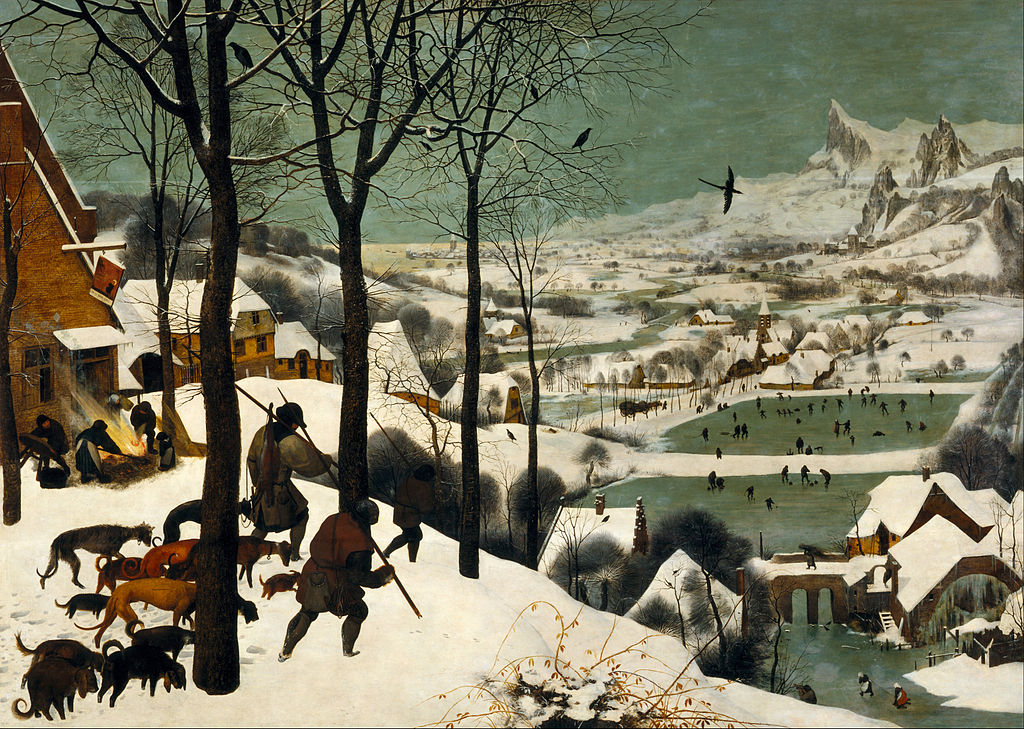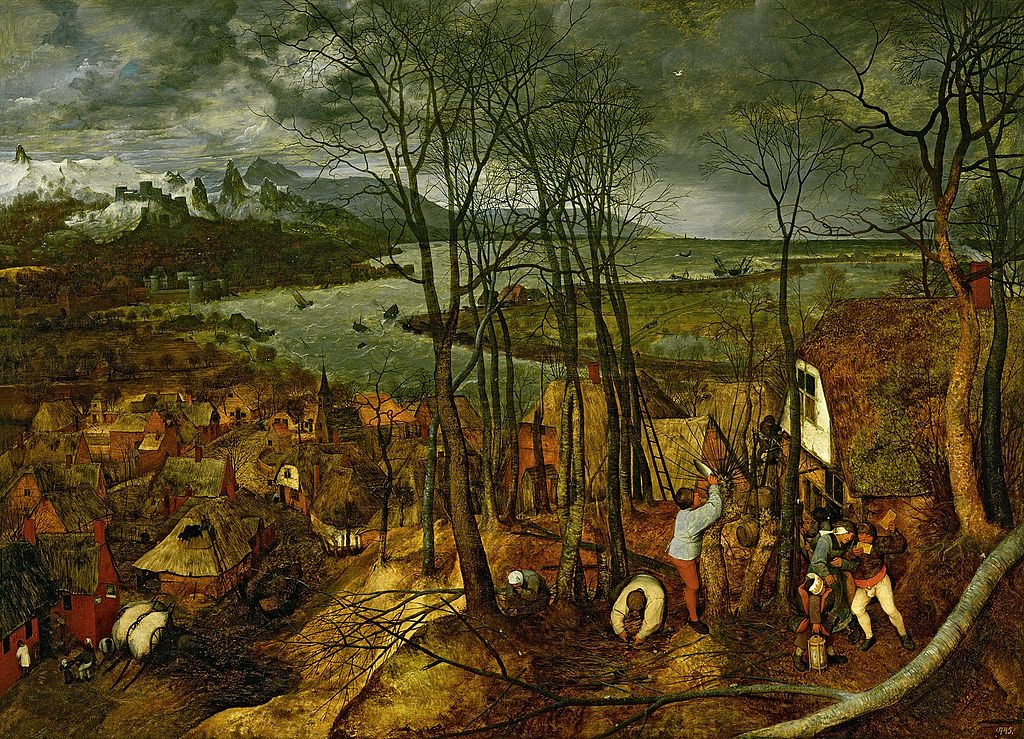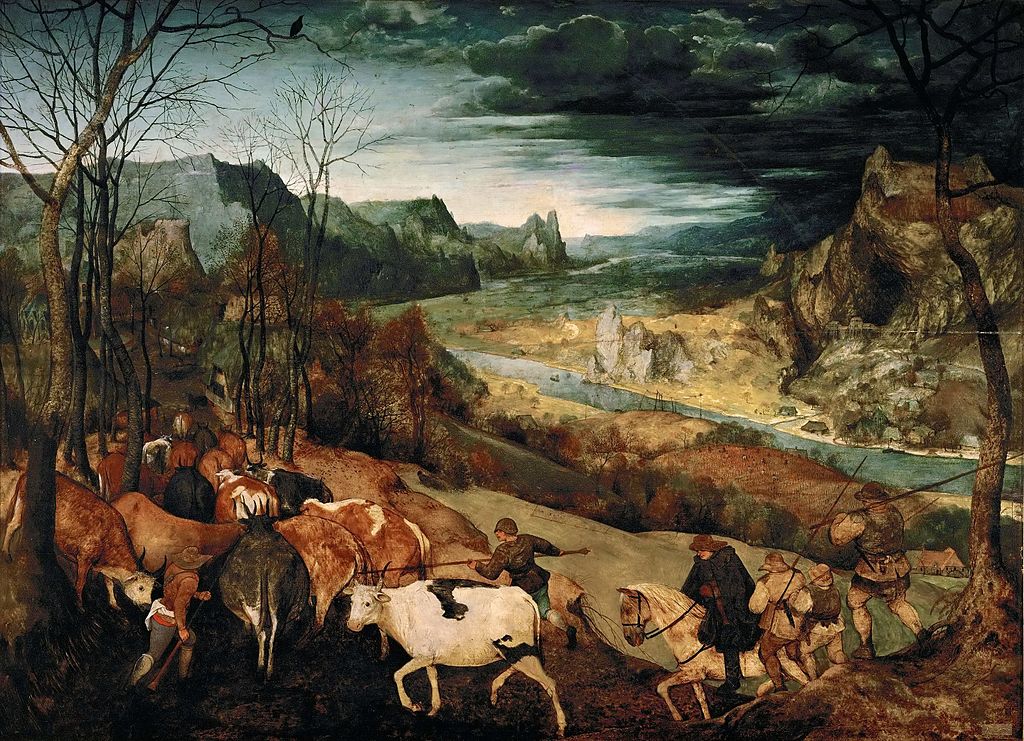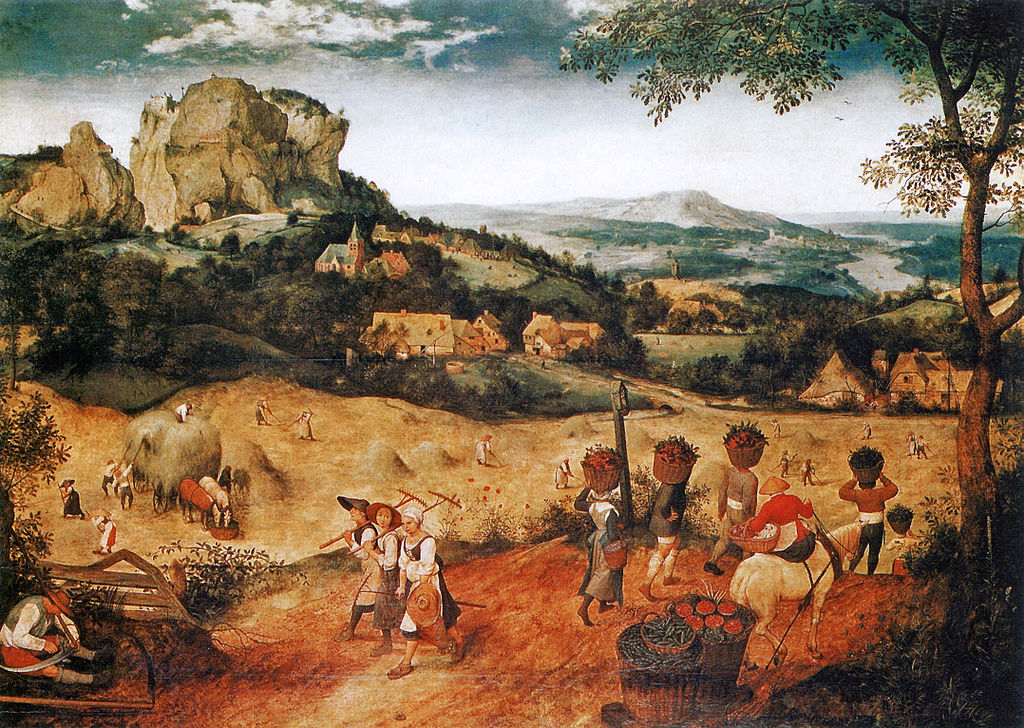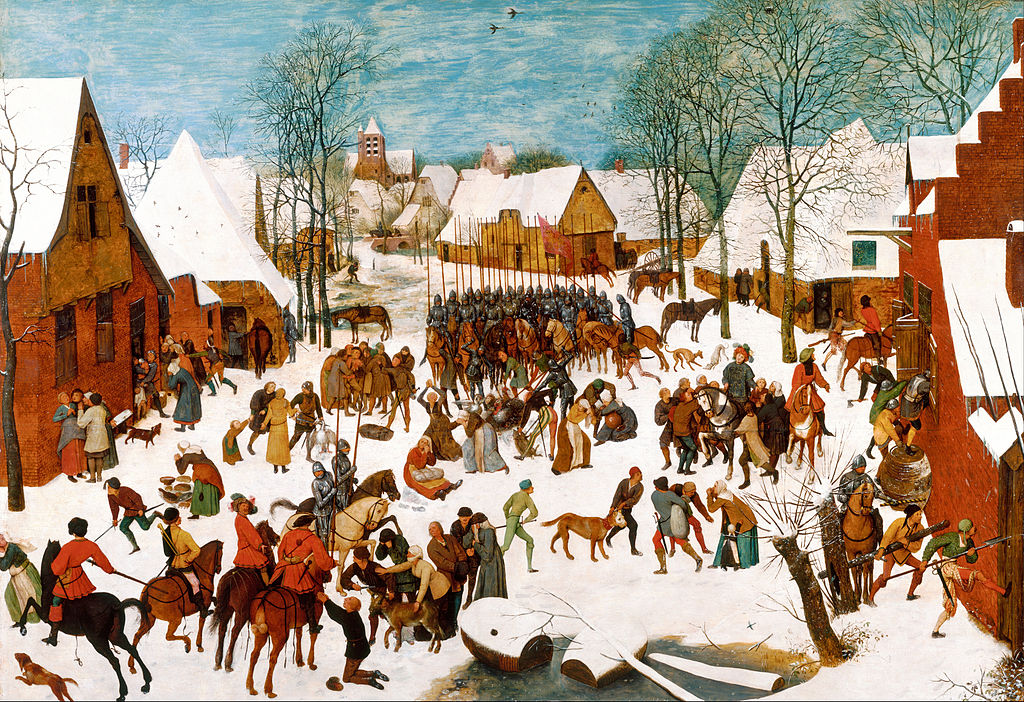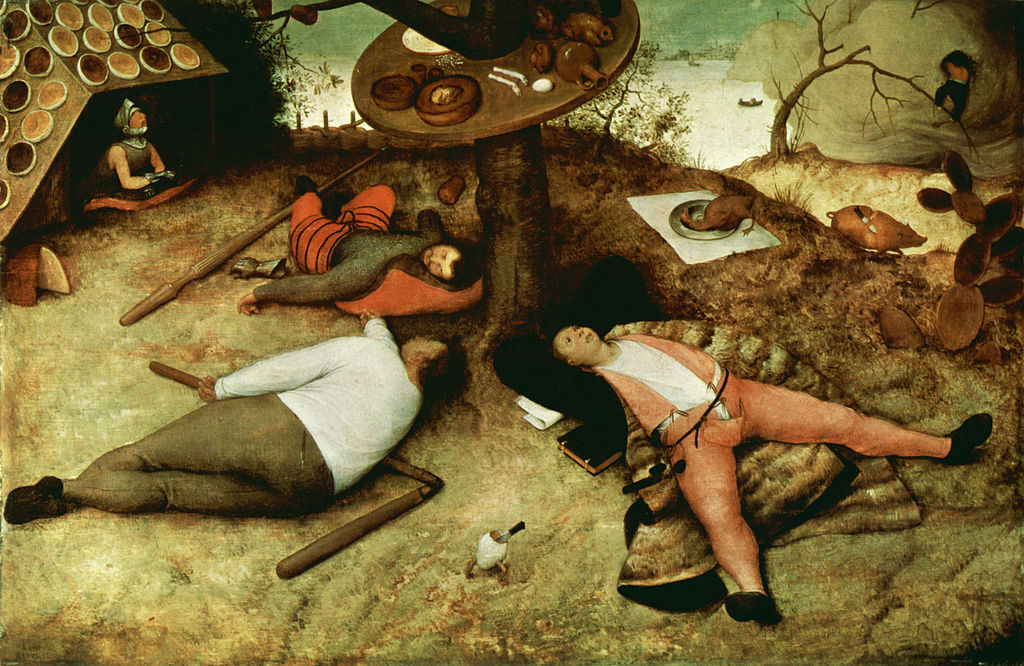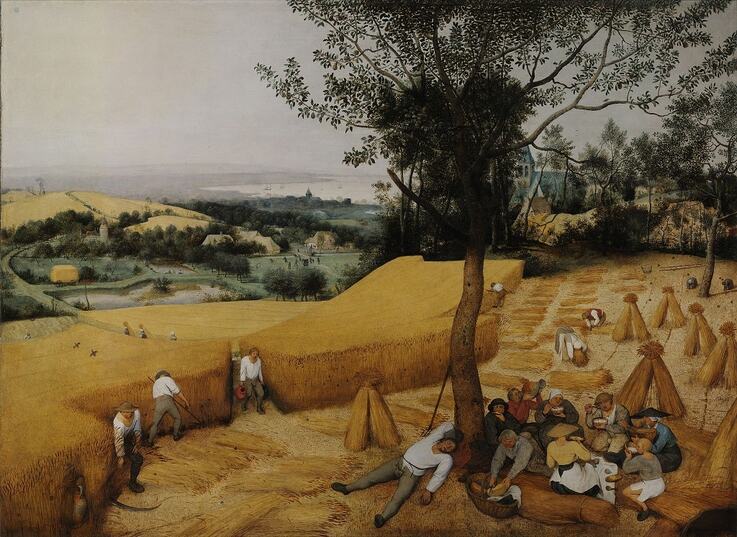|
Where? Room X on the First Floor of the Kunsthistorisches Museum
When? 1565 Commissioned by? Niclaes Jongelinck, a Belgian art collector and banker. What do you see? In the left foreground, a group of peasant hunters and their dogs trudge through heavy snow as they return home from a search for food. It looks like their day was largely unsuccessful as only one hunter carries the cadaver of a small fox, and the dogs look somewhat underfed. Slowly, they pass by a group of villagers roasting corn over a fire at the inn on the far left. The sign hanging above the inn falls lopsided, skewed, maybe by the wind. In front of the hunters are the footprints of a small animal, perhaps a rabbit that has escaped them. The dogs continue sniffing at the ground in the hopes of finding it. The hunters can already see their village. Tiny figures and silhouettes are scattered across the frozen waters as they play curling, hockey, and skate around in groups. Even further behind them are more white and brown houses surrounded by dead trees and black birds, bridges, and pointed towers all dwarfed by the massive snowy mountains that loom over the entire scene. Backstory: Pieter Bruegel the Elder created Hunters in the Snow as part of his series, the Seasons. Bruegel painted scenes of autumn, winter, early spring, early summer, and summer and a sixth painting of spring has not survived. The surviving pieces of this series include: The Gloomy Day, The Harvesters, The Return of the Herd, and The Hay Harvest. Two of these paintings are in the Kunsthistorisches Museum in Vienna, one is in Prague, and the last painting is in the Metropolitan Museum of Art. The six part series once included a painting of spring that was lost. The Seasons were commissioned for the dining room of Nicolaes Jonghelinck, a wealthy merchant and art collector from Antwerp. It’s likely that the paintings were spread out as a frieze on all four walls of the room, creating an immersive experience for the viewer. Hunters in the Snow is Bruegel’s depiction of winter. As with all his pieces, Bruegel packs each of his works with such great detail that many of the miniature scenes he creates are impossible to see with the naked eye. With these details, he crafts a realistic and immersive scene that draws viewers in and plants them into a familiar but fantastical world. Much of his work is concerned with the life of the peasant whom he respected. He gave viewers a look into the parts of their daily life.
Who is Bruegel the Elder? Pieter Bruegel the Elder was a Dutch painter who was born near Breda in 1525. Bruegel began his art career in 1555 at the Antwerp School of Art, where he created many engravings, mostly on the topic of sin, learning from the style of Hieronymous Bosch. In 1563, Bruegel left Antwerp and moved to Brussels where he would remain until his death. During this time, Bruegel began to paint more, creating his Seasons series as well as his Massacre of the Innocents in the Royal Collection in London. Much of his work was focused on day-to-day life and reality, standing in contrast to the Renaissance movement in Italy during this time.
Towards the end of his life, Bruegel painted in a “large-figure” style that sought to imitate the rhythm of dance. Works in this style include his The Blind Leading the Blind and The Land of Cockaigne. His attention to reality and detail made him one of the world’s first truly modern painters. Bruegel died in Brussels in 1569. 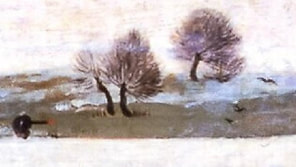 Detail of hunter shooting birds Detail of hunter shooting birds
Fun fact: Bruegel the Elder incorporated many details in his paintings, something that was characteristic of the Northern Renaissance style. A century before, Jan van Eyck had started this style. But Bruegel took this to another level. Some of these details can barely be seen with the naked eye. One of these includes a little hunter with a rifle shooting at some birds on the right side of the painting. With these minuscule details, Bruegel is able to create a world full of depth and truth.
0 Comments
Where? Room 642 of the Metropolitan Museum of Art
When? 1565 Commissioned by? Niclaes Jongelinck, a Belgian art collector and banker. What do you see? This painting depicts the late summer harvest in Belgium. Imagine yourself standing on top of the hill in the foreground observing and listening to this 16th-century agricultural scene. Against a background of low hills and a valley, you can see more than 40 people in this painting engaged in various activities (the longer you look at this painting, the more people you discover). In the right foreground, next to the large pear tree (you can see the pears hanging in the tree), a group of hungry people is eating and drinking. They are consuming bowls with milk and cereals, pears from the tree, bread, and cheese. The person on the left of this group already fell asleep with his pants half open. You can see a church tower hidden behind the trees, just to the right of the large tree in the foreground. To the left of this group, a young man with a jar of water walks up the hill through the path that cuts through the beautiful golden wheat field. Several people are mowing the grain strains with scythes, others are binding the strains together into sheaves, and others carry the sheaves down the hill. You can also see a cart full of wheat driving down the hill. There are many more details that you can discover. For example, on top of the wheat field on the left are two birds searching for food. On the complete right, you can see a person in a tree shaking out the apples that the kids on the ground are picking up. In the middle background, you can see the sea with several boats on it. Backstory: This painting on the harvest by the peasants in Belgium is part of a series of paintings by Bruegel that shows the agricultural activities that are usual for the different months of the year. The series probably consists of six paintings and The Harvesters represents the months July and August. Four other paintings of this series have survived: The Gloomy Day, Hunters in the Snow, The Return of the Herd, and The Hay Harvest. Three of these paintings are in the Kunsthistorisches Museum in Vienna, and the other one is in Prague. The sixth painting in this series has probably not survived (though some people think that the full series even consisted of 12 paintings). Typical for Bruegel, he did not romanticize this agricultural scene but painted a realistic picture of the peasants in late summer. 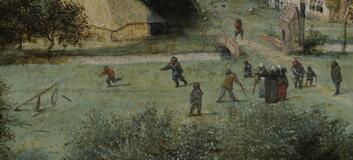 Cock Throwing Cock Throwing
Modifications to this painting: The Metropolitan Museum of Art acquired this painting in 1919. When they cleaned the painting and analyzed it, they noticed that Bruegel modified this painting on the canvas itself. Under the painting, an initial drawing of Bruegel was discovered, before he started painting it. Bruegel made several changes to this painting while painting it. For example, the right hand of the sleeping man next to the tree was in an awkward position, and Bruegel decided later to add a cap to this man that was slipping from his head to cover up this hand. If you look carefully, you can still see the bottom of his right arm through the cap.
Another example is that he first painted the church and later decided to add a branch to the pear tree to cover part of the church tower. You can see the rest of the church tower under the branch. The reason that you can see these modifications is that Bruegel used only a thin layer of paint that became somewhat transparent over time. What is humanism? Pieter Bruegel the Elder was one of the early painters that abandoned the religious or classical themes in his paintings and focused instead on the people. This focus on people was in line with the humanist movement in society. Bruegel seemed to have been well-educated and had many humanist friends. Humanism puts the human being central and focuses on the values and behaviors of people. The impact of humanism on art was a focus on realistic depictions of people and their environments. This realism can clearly be observed in the works of Bruegel. Who is Bruegel the Elder? Pieter Bruegel the Elder was born between 1525 and 1530 in Breda in The Netherlands and died in 1569 in Brussels (his name is sometimes spelled as Brueghel). Opposite to the popular High Renaissance style developed in Italy during that time, Bruegel used a more realistic painting style which we now classify as the Northern Renaissance style. Bruegel was a specialist in genre art (scenes from everyday life) and specifically in painting landscapes and depicting peasants. The artistic talent ran in the Bruegel family, and several people in his family tree were accomplished painters as well, including the two sons of Pieter Bruegel the Elder: Jan Brueghel the Elder and Pieter Brueghel the Younger. Fun fact: A group of about ten people in the middle of the paintings is playing a game. This game is identified as cock throwing, which was especially popular in England. On the left, you can see a rooster tied to a branch hanging in the air. The goal of the game was that people would throw sticks at the rooster until it died. The person who killed the rooster could keep it. Cock throwing is a so-called blood sport, a category of games that involved the killing or injuring of animals. These blood sports were quite popular in the 16th century. An even more popular blood sport around that time was cockfighting, a sport that is still practiced in some countries nowadays. Interested in a copy for yourself? Poster or canvas. |
Categories
All
|
- Home
- Blog
-
Museums
- Alte Pinakothek
- Art Institute of Chicago
- Baltimore Museum of Art
- Barber Institute of Fine Arts
- Bargello
- Barnes Foundation
- British Museum
- Church of Sant’Anastasia
- Cleveland Museum of Art
- Courtauld Institute of Art
- Detroit Institute of Arts
- Frans Hals Museum
- Galleria Borghese
- Gallerie dell'Accademia
- Getty Museum
- Guggenheim
- Hermitage Museum
- Kunsthistorisches Museum
- Kunstmuseum Basel
- Legion of Honor Museum
- Louvre
- Mauritshuis
- Metropolitan Museum of Art
- Musee d’Orsay
- Museum of Fine Arts in Boston
- Museum of Modern Art
- National Gallery in London
- National Gallery of Art
- National Museum in Poznań
- Norton Simon Museum
- Ny Carlsberg Glyptotek
- Palace of Versailles
- Palazzo Pitti
- Palazzo Vecchio
- Petit Palais
- Philadelphia Museum of Art
- Prado
- Pushkin Museum
- Ravenna Art Museum
- Rijksmuseum
- San Diego Museum of Art
- Santa Maria delle Grazie
- St. Peter's Basilica
- Städel Museum
- Statens Museum for Kunst
- Tate Britain
- Tate Modern
- Timken Museum of Art
- Uffizi
- Vatican Museums
- Wallace Collection
-
Artists
- Altdorfer
- Anguissola
- Berlin Painter
- Bosch
- Botticelli
- Boucher
- Bronzino
- Bruegel the Elder
- Brunelleschi
- Cabanel
- Caillebotte
- Canova
- Caravaggio
- Carpeaux
- Cezanne
- Cimabue
- David
- Degas
- Delacroix
- De Maria
- Donatello
- El Greco
- Fontana
- Fra Angelico
- Fragonard
- Gauguin
- Gentileschi
- Gericault
- Gonzalez-Torres
- Goya
- Hals
- Hogarth
- Hokusai
- Ingres
- Leonardo da Vinci
- Lippi, Filippo
- Longhi, Barbara
- Lorrain
- Makovsky
- Manet
- Massys
- Matisse
- Merian
- Michelangelo
- Mochi
- Modigliani
- Monet
- Panini
- Parmigianino
- Perugino
- Picasso
- Pisanello
- Raphael
- Rembrandt
- Renoir
- Reynolds
- Rivera
- Rodin
- Rubens
- Scultori
- Seurat
- Steen
- Tintoretto
- Titian
- Toulouse-Lautrec
- Turner
- Uccello
- Van der Weyden
- Van Dyck
- Van Eyck
- Van Gogh
- Van Hemessen
- Vasari
- Velazquez
- Vermeer
- Veronese
- Vigée Le Brun
-
Locations
- Books
- About Us

